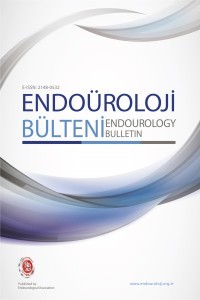Medikal tedaviye dirençli aşırı aktif mesane tedavisinde detrüsör içi botulinum toksin enjeksiyonu
aşırı aktif mesane, dirençli, detrüsör içi onabotulinum toksinA enjeksiyonu
Intradetrusor onabotulinumtoxin A injection for the treatment of overactive bladder resistant to medical therapy
Botulinum toxin, intradetrusor injection onabotulinumtoxin-A, overactive bladder, resistant,
___
- Referans1. Abrams P, Cardozo L, Fall M, et al. The standardisation of terminology of lower urinary tract function: report from the Standardisation Sub-committee of the International Continence Society. Neurourol Urodyn. 2002;21(2):167‐178.
- Referans2. Gormley EA, Lightner DJ, Faraday M, Vasavada SP; American Urological Association; Society of Urodynamics, Female Pelvic Medicine. Diagnosis and treatment of overactive bladder (non-neurogenic) in adults: AUA/SUFU guideline amendment. J Urol. 2015;193(5):1572‐1580.
- Referans 3. Phé V, de Wachter S, Rouprêt M, Chartier-Kastler E. How to define a refractory idiopathic overactive bladder? Neurourol Urodyn. 2015;34(1):2‐11.
- Referans4. Nambiar AK, Bosch R, Cruz F, et al. EAU Guidelines on Assessment and Non-surgical Management of Urinary Incontinence. Eur Urol. 2018;73(4):596‐609.
- Referans5. Nitti VW, Dmochowski R, Herschorn S, et al. OnabotulinumtoxinA for the treatment of patients with overactive bladder and urinary incontinence: results of a phase 3, randomized, placebo controlled trial. J Urol. 2013;189(6):2186‐2193.
- Referans . Onem K, Bayrak O, Demirtas A, et al. Efficacy and safety of onabotulinumtoxinA injection in patients with refractory overactive bladder: First multicentric study in T Turkish population. Neurourol Urodyn. 2018;37(1):263‐268.
- Referans7. Dmochowski R, Chapple C, Nitti VW, et al. Efficacy and safety of onabotulinumtoxinA for idiopathic overactive bladder: a double-blind, placebo controlled, randomized, dose ranging trial. J Urol. 2010;184(6):2416‐2422.
- Referans8. Chermansky CJ, Chancellor MB. Use of Botulinum Toxin in Urologic Diseases. Urology. 2016;91:21‐32.
- Referans9. Tincello DG, Kenyon S, Abrams KR, et al. Botulinum toxin a versus placebo for refractory detrusor overactivity in women: a randomised blinded placebo-controlled trial of 240 women (the RELAX study). Eur Urol. 2012;62(3):507‐514.
- Referans10. Kuo HC. Will suburothelial injection of small dose of botulinum A toxin have similar therapeutic effects and less adverse events for refractory detrusor overactivity?. Urology. 2006;68(5):993‐998.
- Referans11. Jiang YH, Ong HL, Kuo HC. Predictive factors of adverse events after intravesical suburothelial onabotulinumtoxina injections for overactive bladder syndrome-A real-life practice of 290 cases in a single center. Neurourol Urodyn. 2017;36(1):142‐147.
- Yayın Aralığı: Yılda 3 Sayı
- Başlangıç: 2020
- Yayıncı: ENDOÜROLOJİ DERNEĞİ
Medikal tedaviye dirençli aşırı aktif mesane tedavisinde detrüsör içi botulinum toksin enjeksiyonu
Adem Emrah COĞUPLUGİL, Bahadır TOPUZ, Sercan YİLMAZ, Murat ZOR, Mesut GÜRDAL
Burak KÖPRÜ, Turgay EBİLOĞLU, Sinan AKAY, Selçuk SARIKAYA, Murat ZOR, Engin KAYA, Giray ERGİN, İbrahim YAVAN, Mesut GÜRDAL
Huseyin KOCAN, Ilker YİLDİRİM, Sinharib CİTGEZ, Mahmut TOKTAS, Selahattin ÇALIŞKAN, Enver ÖZDEMİR
RIRS’ta tam taşsızlık için prediktif faktörler; güncel bir retrospektif analiz
Gökhan ECER, Mehmet Giray SÖNMEZ, Mehmet BALASAR, Arif AYDIN, Ahmet ÖZTÜRK
Sercan YİLMAZ, Bahadır TOPUZ, Can SİCİMLİ, Adem Emrah COĞUPLUGİL, Engin KAYA, Murat ZOR, Selahattin BEDİR
Erhan DEMİRELLİ, Ercan ÖĞREDEN, Mefail AKSU, Mehmet KARADAYI, Ural OĞUZ
